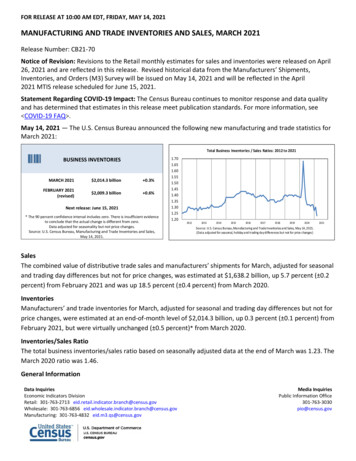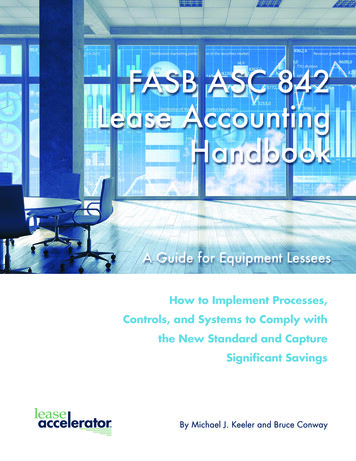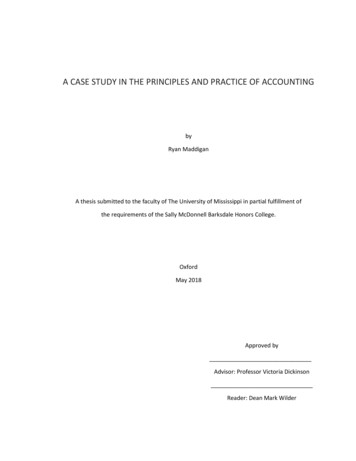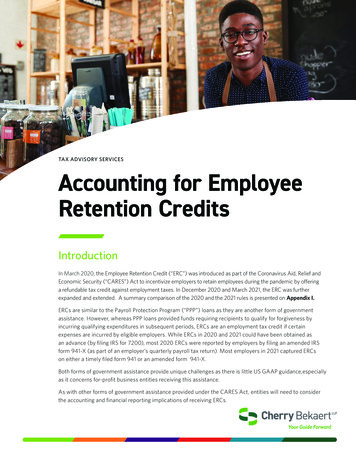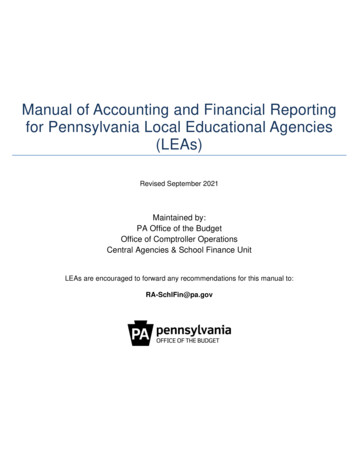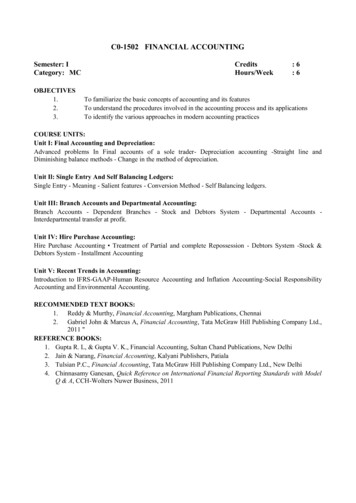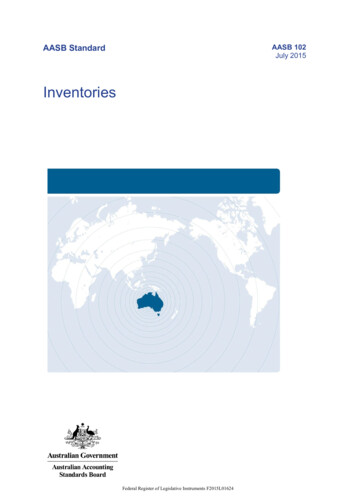
Transcription
AASB 102July 2015AASB StandardInventoriesFederal Register of Legislative Instruments F2015L01624
Obtaining a copy of this Accounting StandardThis Standard is available on the AASB website: www.aasb.gov.au.Australian Accounting Standards BoardPO Box 204Collins Street WestVictoria 8007AUSTRALIAPhone:E-mail:Website:(03) 9617 7637publications@aasb.gov.auwww.aasb.gov.auOther enquiriesPhone:E-mail:(03) 9617 7600standard@aasb.gov.auCOPYRIGHT Commonwealth of Australia 2015This AASB Standard contains IFRS Foundation copyright material. Reproduction within Australia in unaltered form(retaining this notice) is permitted for personal and non-commercial use subject to the inclusion of anacknowledgment of the source. Requests and enquiries concerning reproduction and rights for commercial purposeswithin Australia should be addressed to The Director of Finance and Administration, Australian Accounting StandardsBoard, PO Box 204, Collins Street West, Victoria 8007.All existing rights in this material are reserved outside Australia. Reproduction outside Australia in unaltered form(retaining this notice) is permitted for personal and non-commercial use only. Further information and requests forauthorisation to reproduce for commercial purposes outside Australia should be addressed to the IFRS Foundation atwww.ifrs.org.ISSN 1036-4803AASB 1022Federal Register of Legislative Instruments F2015L01624COPYRIGHT
ContentsCOMPARISON WITH IAS 2ACCOUNTING STANDARDAASB 102 INVENTORIESOBJECTIVESCOPEDEFINITIONSMEASUREMENT OF INVENTORIESCost of inventoriesCosts of purchaseCosts of conversionOther costsCost of inventories of a service providerCost of agricultural produce harvested from biological assetsTechniques for the measurement of costCost formulasNet realisable valueRECOGNITION AS AN EXPENSEDISCLOSUREEFFECTIVE DATEWITHDRAWAL OF OTHER PRONOUNCEMENTSTRANSITIONCOMMENCEMENT OF THE LEGISLATIVE INSTRUMENTWITHDRAWAL OF AASB PRONOUNCEMENTSAPPENDICESA Australian defined termsB Australian reduced disclosure requirementsDELETED IAS 2 TEXTBASIS FOR CONCLUSIONS ON AASB 2007-5from 2.3Aus42.4AVAILABLE ON THE AASB WEBSITEBasis for Conclusions on IAS 2Australian Accounting Standard AASB 102 Inventories is set out in paragraphs 1 – Aus42.4 and Appendices A – B.All the paragraphs have equal authority. Paragraphs in bold type state the main principles. AASB 102 is to be readin the context of other Australian Accounting Standards, including AASB 1048 Interpretation of Standards, whichidentifies the Australian Accounting Interpretations, and AASB 1057 Application of Australian Accounting Standards.In the absence of explicit guidance, AASB 108 Accounting Policies, Changes in Accounting Estimates and Errorsprovides a basis for selecting and applying accounting policies.AASB 1023Federal Register of Legislative Instruments F2015L01624CONTENTS
Comparison with IAS 2AASB 102 Inventories incorporates IAS 2 Inventories issued by the International Accounting Standards Board(IASB). Australian-specific paragraphs (which are not included in IAS 2) are identified with the prefix “Aus” or“RDR”. Paragraphs that apply only to not-for-profit entities begin by identifying their limited applicability.Tier 1For-profit entities complying with AASB 102 also comply with IAS 2.Not-for-profit entities’ compliance with IAS 2 will depend on whether any “Aus” paragraphs that specifically apply tonot-for-profit entities provide additional guidance or contain applicable requirements that are inconsistent with IAS 2.Tier 2Entities preparing general purpose financial statements under Australian Accounting Standards – Reduced DisclosureRequirements (Tier 2) will not be in compliance with IFRSs.AASB 1053 Application of Tiers of Australian Accounting Standards explains the two tiers of reporting requirements.AASB 1024Federal Register of Legislative Instruments F2015L01624COMPARISON
Accounting Standard AASB 102The Australian Accounting Standards Board makes Accounting Standard AASB 102 Inventories under section 334 ofthe Corporations Act 2001.Kris PeachChair – AASBDated 24 July 2015Accounting Standard AASB 102InventoriesObjective1The objective of this Standard is to prescribe the accounting treatment for inventories. A primary issue inaccounting for inventories is the amount of cost to be recognised as an asset and carried forward until therelated revenues are recognised. This Standard provides guidance on the determination of cost and itssubsequent recognition as an expense, including any write-down to net realisable value. It also providesguidance on the cost formulas that are used to assign costs to inventories.Scope2This Standard applies to all inventories, except:(a)[deleted](b)financial instruments (see AASB 132 Financial Instruments: Presentation and AASB 9Financial Instruments); and(c)biological assets related to agricultural activity and agricultural produce at the point ofharvest (see AASB 141 Agriculture).Aus2.13Notwithstanding paragraph 2, in respect of not-for-profit entities, this Standard does notapply to work in progress of services to be provided for no or nominal considerationdirectly in return from the recipients.This Standard does not apply to the measurement of inventories held by:(a)producers of agricultural and forest products, agricultural produce after harvest, andminerals and mineral products, to the extent that they are measured at net realisable valuein accordance with well-established practices in those industries. When such inventories aremeasured at net realisable value, changes in that value are recognised in profit or loss in theperiod of the change.(b)commodity broker-traders who measure their inventories at fair value less costs to sell.When such inventories are measured at fair value less costs to sell, changes in fair value lesscosts to sell are recognised in profit or loss in the period of the change.4The inventories referred to in paragraph 3(a) are measured at net realisable value at certain stages ofproduction. This occurs, for example, when agricultural crops have been harvested or minerals have beenextracted and sale is assured under a forward contract or a government guarantee, or when an active marketexists and there is a negligible risk of failure to sell. These inventories are excluded from only themeasurement requirements of this Standard.5Broker-traders are those who buy or sell commodities for others or on their own account. The inventoriesreferred to in paragraph 3(b) are principally acquired with the purpose of selling in the near future andgenerating a profit from fluctuations in price or broker-traders’ margin. When these inventories aremeasured at fair value less costs to sell, they are excluded from only the measurement requirements of thisStandard.AASB 1025Federal Register of Legislative Instruments F2015L01624STANDARD
Definitions6The following terms are used in this Standard with the meanings specified:Inventories are assets:(a)held for sale in the ordinary course of business;(b)in the process of production for such sale; or(c)in the form of materials or supplies to be consumed in the production process or in therendering of services.Net realisable value is the estimated selling price in the ordinary course of business less the estimatedcosts of completion and the estimated costs necessary to make the sale.Fair value is the price that would be received to sell an asset or paid to transfer a liability in anorderly transaction between market participants at the measurement date. (See AASB 13 Fair ValueMeasurement.)7Net realisable value refers to the net amount that an entity expects to realise from the sale of inventory inthe ordinary course of business. Fair value reflects the price at which an orderly transaction to sell the sameinventory in the principal (or most advantageous) market for that inventory would take place betweenmarket participants at the measurement date. The former is an entity-specific value; the latter is not. Netrealisable value for inventories may not equal fair value less costs to sell.8Inventories encompass goods purchased and held for resale including, for example, merchandise purchasedby a retailer and held for resale, or land and other property held for resale. Inventories also encompassfinished goods produced, or work in progress being produced, by the entity and include materials andsupplies awaiting use in the production process. Costs incurred to fulfil a contract with a customer that donot give rise to inventories (or assets within the scope of another Standard) are accounted for in accordancewith AASB 15 Revenue from Contracts with Customers.Measurement of inventories9Inventories shall be measured at the lower of cost and net realisable value.Aus9.1Notwithstanding paragraph 9, each not-for-profit entity shall measure inventories held fordistribution at cost, adjusted when applicable for any loss of service potential.Aus9.2Not-for-profit entities would need to use judgment in determining the factors relevant to thecircumstances in assessing whether there is a loss of service potential for inventories held fordistribution. For many inventories held for distribution, a loss of service potential would beidentified and measured based on the existence of a current replacement cost that is lower thanthe original acquisition cost or other subsequent carrying amount. For other inventories held fordistribution, a loss of service potential might be identified and measured based on a loss ofoperating capacity due to obsolescence. Different bases for determining whether there has been aloss of service potential and the measurement of that loss may apply to different inventories heldfor distribution within the same entity.Cost of inventories10The cost of inventories shall comprise all costs of purchase, costs of conversion and other costsincurred in bringing the inventories to their present location and condition.Aus10.1Notwithstanding paragraph 10, in respect of not-for-profit entities, where inventories areacquired at no cost, or for nominal consideration, the cost shall be the current replacementcost as at the date of acquisition.Costs of purchase11The costs of purchase of inventories comprise the purchase price, import duties and other taxes (other thanthose subsequently recoverable by the entity from the taxing authorities), and transport, handling and othercosts directly attributable to the acquisition of finished goods, materials and services. Trade discounts,rebates and other similar items are deducted in determining the costs of purchase.AASB 1026Federal Register of Legislative Instruments F2015L01624STANDARD
Costs of conversion12The costs of conversion of inventories include costs directly related to the units of production, such as directlabour. They also include a systematic allocation of fixed and variable production overheads that areincurred in converting materials into finished goods. Fixed production overheads are those indirect costs ofproduction that remain relatively constant regardless of the volume of production, such as depreciation andmaintenance of factory buildings and equipment, and the cost of factory management and administration.Variable production overheads are those indirect costs of production that vary directly, or nearly directly,with the volume of production, such as indirect materials and indirect labour.13The allocation of fixed production overheads to the costs of conversion is based on the normal capacity ofthe production facilities. Normal capacity is the production expected to be achieved on average over anumber of periods or seasons under normal circumstances, taking into account the loss of capacity resultingfrom planned maintenance. The actual level of production may be used if it approximates normal capacity.The amount of fixed overhead allocated to each unit of production is not increased as a consequence of lowproduction or idle plant. Unallocated overheads are recognised as an expense in the period in which they areincurred. In periods of abnormally high production, the amount of fixed overhead allocated to each unit ofproduction is decreased so that inventories are not measured above cost. Variable production overheads areallocated to each unit of production on the basis of the actual use of the production facilities.14A production process may result in more than one product being produced simultaneously. This is the case,for example, when joint products are produced or when there is a main product and a by-product. When thecosts of conversion of each product are not separately identifiable, they are allocated between the productson a rational and consistent basis. The allocation may be based, for example, on the relative sales value ofeach product either at the stage in the production process when the products become separately identifiable,or at the completion of production. Most by-products, by their nature, are immaterial. When this is the case,they are often measured at net realisable value and this value is deducted from the cost of the main product.As a result, the carrying amount of the main product is not materially different from its cost.Other costs15Other costs are included in the cost of inventories only to the extent that they are incurred in bringing theinventories to their present location and condition. For example, it may be appropriate to include nonproduction overheads or the costs of designing products for specific customers in the cost of inventories.16Examples of costs excluded from the cost of inventories and recognised as expenses in the period in whichthey are incurred are:(a)abnormal amounts of wasted materials, labour or other production costs;(b)storage costs, unless those costs are necessary in the production process before a furtherproduction stage;(c)administrative overheads that do not contribute to bringing inventories to their present locationand condition; and(d)selling costs.17AASB 123 Borrowing Costs identifies limited circumstances where borrowing costs are included in the costof inventories.18An entity may purchase inventories on deferred settlement terms. When the arrangement effectivelycontains a financing element, that element, for example a difference between the purchase price for normalcredit terms and the amount paid, is recognised as interest expense over the period of the financing.Cost of inventories of a service provider19[Deleted]Cost of agricultural produce harvested from biological assets20In accordance with AASB 141 Agriculture inventories comprising agricultural produce that an entity hasharvested from its biological assets are measured on initial recognition at their fair value less costs to sell atthe point of harvest. This is the cost of the inventories at that date for application of this Standard.AASB 1027Federal Register of Legislative Instruments F2015L01624STANDARD
Techniques for the measurement of cost21Techniques for the measurement of the cost of inventories, such as the standard cost method or the retailmethod, may be used for convenience if the results approximate cost. Standard costs take into accountnormal levels of materials and supplies, labour, efficiency and capacity utilisation. They are regularlyreviewed and, if necessary, revised in the light of current conditions.22The retail method is often used in the retail industry for measuring inventories of large numbers of rapidlychanging items with similar margins for which it is impracticable to use other costing methods. The cost ofthe inventory is determined by reducing the sales value of the inventory by the appropriate percentage grossmargin. The percentage used takes into consideration inventory that has been marked down to below itsoriginal selling price. An average percentage for each retail department is often used.Cost formulas23The cost of inventories of items that are not ordinarily interchangeable and goods or servicesproduced and segregated for specific projects shall be assigned by using specific identification of theirindividual costs.24Specific identification of cost means that specific costs are attributed to identified items of inventory. Thisis the appropriate treatment for items that are segregated for a specific project, regardless of whether theyhave been bought or produced. However, specific identification of costs is inappropriate when there arelarge numbers of items of inventory that are ordinarily interchangeable. In such circumstances, the methodof selecting those items that remain in inventories could be used to obtain predetermined effects on profit orloss.25The cost of inventories, other than those dealt with in paragraph 23, shall be assigned by using thefirst-in, first-out (FIFO) or weighted average cost formula. An entity shall use the same cost formulafor all inventories having a similar nature and use to the entity. For inventories with a differentnature or use, different cost formulas may be justified.26For example, inventories used in one operating segment may have a use to the entity different from thesame type of inventories used in another operating segment. However, a difference in geographical locationof inventories (or in the respective tax rules), by itself, is not sufficient to justify the use of different costformulas.27The FIFO formula assumes that the items of inventory that were purchased or produced first are sold first,and consequently the items remaining in inventory at the end of the period are those most recentlypurchased or produced. Under the weighted average cost formula, the cost of each item is determined fromthe weighted average of the cost of similar items at the beginning of a period and the cost of similar itemspurchased or produced during the period. The average may be calculated on a periodic basis, or as eachadditional shipment is received, depending upon the circumstances of the entity.Net realisable value28The cost of inventories may not be recoverable if those inventories are damaged, if they have becomewholly or partially obsolete, or if their selling prices have declined. The cost of inventories may also not berecoverable if the estimated costs of completion or the estimated costs to be incurred to make the sale haveincreased. The practice of writing inventories down below cost to net realisable value is consistent with theview that assets should not be carried in excess of amounts expected to be realised from their sale or use.29Inventories are usually written down to net realisable value item by item. In some circumstances, however,it may be appropriate to group similar or related items. This may be the case with items of inventoryrelating to the same product line that have similar purposes or end uses, are produced and marketed in thesame geographical area, and cannot be practicably evaluated separately from other items in that productline. It is not appropriate to write inventories down on the basis of a classification of inventory, for example,finished goods, or all the inventories in a particular operating segment.30Estimates of net realisable value are based on the most reliable evidence available at the time the estimatesare made, of the amount the inventories are expected to realise. These estimates take into considerationfluctuations of price or cost directly relating to events occurring after the end of the period to the extent thatsuch events confirm conditions existing at the end of the period.31Estimates of net realisable value also take into consideration the purpose for which the inventory is held.For example, the net realisable value of the quantity of inventory held to satisfy firm sales or servicecontracts is based on the contract price. If the sales contracts are for less than the inventory quantities held,the net realisable value of the excess is based on general selling prices. Provisions may arise from firm salesAASB 1028Federal Register of Legislative Instruments F2015L01624STANDARD
contracts in excess of inventory quantities held or from firm purchase contracts. Such provisions are dealtwith under AASB 137 Provisions, Contingent Liabilities and Contingent Assets.32Materials and other supplies held for use in the production of inventories are not written down below cost ifthe finished products in which they will be incorporated are expected to be sold at or above cost. However,when a decline in the price of materials indicates that the cost of the finished products exceeds net realisablevalue, the materials are written down to net realisable value. In such circumstances, the replacement cost ofthe materials may be the best available measure of their net realisable value.33A new assessment is made of net realisable value in each subsequent period. When the circumstances thatpreviously caused inventories to be written down below cost no longer exist or when there is clear evidenceof an increase in net realisable value because of changed economic circumstances, the amount of the writedown is reversed (ie the reversal is limited to the amount of the original write-down) so that the newcarrying amount is the lower of the cost and the revised net realisable value. This occurs, for example, whenan item of inventory that is carried at net realisable value, because its selling price has declined, is still onhand in a subsequent period and its selling price has increased.Recognition as an expense34When inventories are sold, the carrying amount of those inventories shall be recognised as an expensein the period in which the related revenue is recognised. The amount of any write-down of inventoriesto net realisable value and all losses of inventories shall be recognised as an expense in the period thewrite-down or loss occurs. The amount of any reversal of any write-down of inventories, arising froman increase in net realisable value, shall be recognised as a reduction in the amount of inventoriesrecognised as an expense in the period in which the reversal occurs.Aus34.135When inventories held for distribution by a not-for-profit entity are distributed, the carryingamount of those inventories shall be recognised as an expense. The amount of any write-down ofinventories for loss of service potential and all losses of inventories shall be recognised as anexpense in the period in which the write-down or loss occurs. The amount of any reversal of anywrite-down of inventories arising from a reversal of the circumstances that gave rise to the loss ofservice potential shall be recognised as a reduction in the amount of inventories recognised as anexpense in the period in which the reversal occurs.Some inventories may be allocated to other asset accounts, for example, inventory used as a component ofself-constructed property, plant or equipment. Inventories allocated to another asset in this way arerecognised as an expense during the useful life of that asset.Disclosure36The financial statements shall disclose:(a)the accounting policies adopted in measuring inventories, including the cost formula used;(b)the total carrying amount of inventories and the carrying amount in classificationsappropriate to the entity;(c)the carrying amount of inventories carried at fair value less costs to sell;(d)the amount of inventories recognised as an expense during the period;(e)the amount of any write-down of inventories recognised as an expense in the period inaccordance with paragraph 34;(f)the amount of any reversal of any write-down that is recognised as a reduction in theamount of inventories recognised as expense in the period in accordance with paragraph 34;(g)the circumstances or events that led to the reversal of a write-down of inventories inaccordance with paragraph 34; and(h)the carrying amount of inventories pledged as security for liabilities.Aus36.1Notwithstanding paragraph 36, in respect of not-for-profit entities, the financial statementsshall disclose:(a)AASB 102the accounting policies adopted in measuring inventories held for distribution,including the cost formula used;9Federal Register of Legislative Instruments F2015L01624STANDARD
(b)the total carrying amount of inventories held for distribution and the carryingamount in classifications appropriate to the entity;(c)the amount of inventories held for distribution recognised as an expense duringthe period in accordance with paragraph Aus34.1;(d)the amount of any write-down of inventories held for distribution recognised as anexpense in the period in accordance with paragraph Aus34.1;(e)the amount of any reversal of any write-down that is recognised as a reduction inthe amount of inventories held for distribution recognised as expense in the periodin accordance with paragraph Aus34.1;(f)the circumstances or events that led to the reversal of a write-down of inventoriesheld for distribution in accordance with paragraph Aus34.1;(g)the carrying amount of inventories held for distribution pledged as security forliabilities; and(h)the basis on which any loss of service potential of inventories held for distributionis assessed, or the bases when more than one basis is used.37Information about the carrying amounts held in different classifications of inventories and the extent of thechanges in these assets is useful to financial statement users. Common classifications of inventories aremerchandise, production supplies, materials, work in progress and finished goods.38The amount of inventories recognised as an expense during the period, which is often referred to as cost ofsales, consists of those costs previously included in the measurement of inventory that has now been soldand unallocated production overheads and abnormal amounts of production costs of inventories. Thecircumstances of the entity may also warrant the inclusion of other amounts, such as distribution costs.39Some entities adopt a format for profit or loss that results in amounts being disclosed other than the cost ofinventories recognised as an expense during the period. Under this format, an entity presents an analysis ofexpenses using a classification based on the nature of expenses. In this case, the entity discloses the costsrecognised as an expense for raw materials and consumables, labour costs and other costs together with theamount of the net change in inventories for the period.Effective date40An entity shall apply this Standard for annual periods beginning on or after 1 January 2018. Earlierapplication is encouraged for periods beginning after 24 July 2014 but before 1 January 2018. If an entityapplies this Standard for a period beginning before 1 January 2018, it shall disclose that fact.40A[Deleted]40B[Deleted]40C[Deleted by the AASB]40D[Deleted]40EAASB 2014-5 Amendments to Australian Accounting Standards arising from AASB 15, issued in December2014, amended the previous version of this Standard as follows: amended paragraphs 2, 8, 29 and 37 anddeleted paragraph 19. An entity shall apply those amendments when it applies AASB 15.40FAASB 2010-7 Amendments to Australian Accounting Standards arising from AASB 9 (December 2010) (asamended) amended the previous version of this Standard as follows: amended paragraph 2(b) and deletedparagraph 40A. Paragraph 40B, added by AASB 2010-7, was deleted by AASB 2014-1 Amendments toAustralian Accounting Standards. Paragraph 40D, added by AASB 2014-1 was deleted by AASB 2014-7Amendments to Australian Accounting Standards arising from AASB 9 (December 2014). An entity shallapply those amendments when it applies AASB 9.Withdrawal of other pronouncements41–42[Deleted by the AASB]AASB 10210Federal Register of Legislative Instruments F2015L01624STANDARD
TransitionAus42.1Not-for-profit entities shall apply paragraph Aus9.1 and measure inventories held fordistribution at cost, adjusted when applicable for any loss of service potential, on aprospective basis from the beginning of the annual period to which this Standard is firstapplied.Aus42.2Under paragraph Aus42.1, not-for-profit entities shall make any necessary adjustment to theopening balance of inventories held for distribution, previously carried at the lower of cost andcurrent replacement cost, against opening retained earnings for the current annual period.Accordingly, comparative information is not adjusted.Commencement of the legislative instrumentAus42.3For legal purposes, this legislative instrument commences on 31 December 2017.Withdrawal of AASB pronouncementsAus42.4This Standard repeals AASB 102 Inventories issued in July 2004. Despite the repeal, after thetime this Standard starts to apply under section 334 of the Corporations Act (either generally or inrelation to an individual entity), the repealed Standard continues to apply in relation to any periodending before that time as if the repeal had not occurred.[Note: When this Standard applies under section 334 of the Corporations Act (either generally orin relation to an individual entity), it supersedes the application of the repealed Standard.]AASB 10211Federal Register of Legislative Instruments F2015L01624STANDARD
Appendix AAustralian defined termsThis appendix is an integral part of AASB 102.Aus6.1The following terms are also used in this Standard with the meanings specified.A not-for-profit entity is an entity whose principal objective is not the generation of profit. Anot-for-profit entity can be a single entity or a group of entities comprising the parent entityand each of the entities that it controls.In respect of not-for-profit entities, current replacement cost is the cost the entity wouldincur to acquire the asset at the end of the reporting period.In respect of not-for-profit entities, inventories held for distribution are assets:(a)held for distribution at no or nominal consideration in the ordinary course ofoperations;(b)in the process of production for distribution at no or nominal consideration in theordinary course of operations; or(c)in the form of materials or supplies to be consumed in the produ
All the paragraphs have equal authority. Paragraphs in bold type state the main principles. AASB 102 is to be read in the context of other Australian Accounting Standards, including AASB 1048 Interpretation of Standards, which identifies the Australian Accounting Interpretations, and AASB 1057 Application of Australian Accounting Standards.
